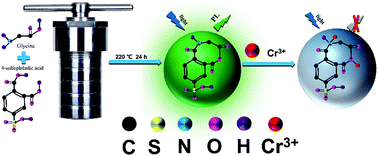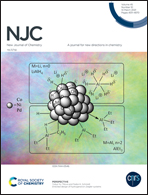Novel fluorescent probes based on nitrogen–sulfur co-doped carbon dots for chromium ion detection†
Abstract
In this work, novel carbon dots codoped with nitrogen and sulfur (NSCDs) were used as fluorescent probes to detect Cr3+. These NSCDs exhibited strong fluorescence, which could be rapidly quenched by Cr3+. The fluorescence intensity of the NSCD solutions would decrease linearly with increasing Cr3+ concentration (0–40 μM). The detection limit was calculated to be 7.8 nM, indicating that the NSCD probes have excellent sensitivity. Then, it was determined that the NSCD probes were quenched only by Cr3+, even in the presence of other ions, thereby showing that the NSCD probes possess excellent anti-interference ability and selectivity. The mechanism of quenching of the fluorescence of NSCDs by Cr3+ ions may be related to the enhanced non-radiation emission attributed to the destroyed NSCD surface. Due to their nontoxicity and biocompatibility, these NSCDs could be applied in the detection of Cr3+ in living cells.



 Please wait while we load your content...
Please wait while we load your content...